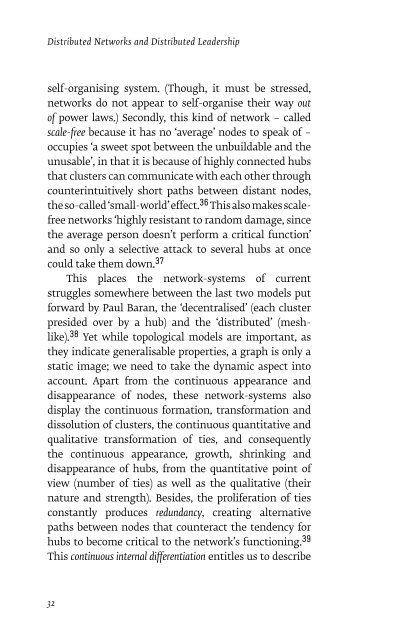Organisation-of-the-Organisationless
Organisation-of-the-Organisationless
Organisation-of-the-Organisationless
You also want an ePaper? Increase the reach of your titles
YUMPU automatically turns print PDFs into web optimized ePapers that Google loves.
Distributed Networks and Distributed Leadership<br />
self-organising system. (Though, it must be stressed,<br />
networks do not appear to self-organise <strong>the</strong>ir way out<br />
<strong>of</strong> power laws.) Secondly, this kind <strong>of</strong> network – called<br />
scale-free because it has no ‘average’ nodes to speak <strong>of</strong> –<br />
occupies ‘a sweet spot between <strong>the</strong> unbuildable and <strong>the</strong><br />
unusable’, in that it is because <strong>of</strong> highly connected hubs<br />
that clusters can communicate with each o<strong>the</strong>r through<br />
counterintuitively short paths between distant nodes,<br />
<strong>the</strong> so-called ‘small-world’ effect. 36 This also makes scalefree<br />
networks ‘highly resistant to random damage, since<br />
<strong>the</strong> average person doesn’t perform a critical function’<br />
and so only a selective attack to several hubs at once<br />
could take <strong>the</strong>m down. 37<br />
This places <strong>the</strong> network-systems <strong>of</strong> current<br />
struggles somewhere between <strong>the</strong> last two models put<br />
forward by Paul Baran, <strong>the</strong> ‘decentralised’ (each cluster<br />
presided over by a hub) and <strong>the</strong> ‘distributed’ (meshlike).<br />
38 Yet while topological models are important, as<br />
<strong>the</strong>y indicate generalisable properties, a graph is only a<br />
static image; we need to take <strong>the</strong> dynamic aspect into<br />
account. Apart from <strong>the</strong> continuous appearance and<br />
disappearance <strong>of</strong> nodes, <strong>the</strong>se network-systems also<br />
display <strong>the</strong> continuous formation, transformation and<br />
dissolution <strong>of</strong> clusters, <strong>the</strong> continuous quantitative and<br />
qualitative transformation <strong>of</strong> ties, and consequently<br />
<strong>the</strong> continuous appearance, growth, shrinking and<br />
disappearance <strong>of</strong> hubs, from <strong>the</strong> quantitative point <strong>of</strong><br />
view (number <strong>of</strong> ties) as well as <strong>the</strong> qualitative (<strong>the</strong>ir<br />
nature and strength). Besides, <strong>the</strong> proliferation <strong>of</strong> ties<br />
constantly produces redundancy, creating alternative<br />
paths between nodes that counteract <strong>the</strong> tendency for<br />
hubs to become critical to <strong>the</strong> network’s functioning. 39<br />
This continuous internal differentiation entitles us to describe<br />
32


